When people ask me, and they do, what is the best place I’ve visited during this trip it is impossible to give them the straight and definite answer that they expect. If you go on a week long holiday to some beach resort you can probably pick out the most exciting thing that happened during that week or if you travel through a couple of countries you can probably pick your favorite among them. But when you have been travelling for fourteen months, visited twenty five countries and stayed in one hundred and fifty different locations, then it becomes a bit more difficult to name your favorite spot or your favorite country. People in general don’t grasp this so they keep expecting me to produce a quick answer to their question.
So therefore have I now decided on a set answer that I can pull out of the sleeve of my motorcycle jacket and present as a ready made definite truth. Here it is: Lesotho.
And although there are other countries that compete for the title, Lesotho is definitely among the contenders. The fact that it is such a tiny country speaks to its advantage. Small countries often get overlooked when the nomination committee makes its final pick as large countries have so much better possibilities to impress a visitor.
Most of my overall favorite countries are indeed large countries but I like to throw in a few small ones in the pile as well, like Guatemala, Singapore and Nepal because each of them is packed to the brim with points of interest and pure beauty. It just isn’t fair to neglect the small countries just because the big giants have so much better possibilities. On the contrary, if a large country has a hard time impressing you it probably deserves a place at the bottom of the popularity list.
On this trip Guinea Bissau and Lesotho are small countries that have impressed me greatly. But to give the questioners what they want I will stick with Lesotho as it is very easy to answer the subsequent question that inevitably will follow: Why?
Because it has one of the world’s most stunning natural beauties. End of discussion.
Lesotho is a small kingdom landlocked within South Africa. Its lowest point is the highest of any country in the world which means it is a mountainous country. The mountains are not spectacularly high neither are they spectacularly dramatic but they are spectacularly beautiful. It is also a very friendly and welcoming country full of life and activity.
In too many places in Africa, I pass through communities where there is an appalling lack of activity and initiative. People sit around in the shade all day long doing absolutely nothing. The fields, if there are any at all, are neglected, the houses barely stand upright and the trash is just left wherever it happens to be at the time it is no longer of any use, usually in the shade under a tree.
Not so in Lesotho. Lesotho is refreshingly clean and all over the landscape there are cultivated fields with crops that are tended to and animals that are herded. People always seem to be on the move as if they were hurrying to do something important. Their houses may be primitive but they are well kept with a clean front porch and often a small garden. It is a poor country monetary wise but it is a culturally and socially rich country where people have at least a little ambition and strive to improve their own situation and not just sit in the shade asking the white dude on the motorcycle to give them something.
Malealea Lodge was the name of the destination on my first day in Lesotho. It is a beautiful name, apparently taken after a chief of the village where the lodge is situated. I had no idea what to expect as I came up a small dirt road towards a minor pass in a mountain ridge. The owner of the guest house where I had stayed the previous night had recommended Malealea so I adjusted my GPS route and headed for this unknown place.

As I came over the pass I had to stop my bike and just gasp at the stunningly beautiful panorama that opened up on the other side. A large valley surrounded by green mountains under a blue sky kept my eyes fixed for several minutes. I refrain from including a photo of this view as it would not in any way do justice to the image that was projected onto my memory.
Where the little dirt road ended was the Malealea Lodge. I didn’t know what kind of place it would be or if they had any room or camping spot available to me. Judging by the road that led there it could have been a paltry concrete building with mildew smelling bed linen without any facilities at all. But I needed not have worried. The Malealea Lodge turned out to be one of the top spots of all places where I have stayed on this trip. It consisted of numerous bungalows built in a style that melted into the surrounding nature. It was not a particularly fancy or expensive place, just very comfortable, very beautiful and with an exceptional view over the valley and the mountains beyond. I camped on their green lawn underneath shading trees. The following day I did nothing but sit and admire the landscape in outmost peace and quiet. At night the Milky Way showed off her brightest display of celestial illumination.
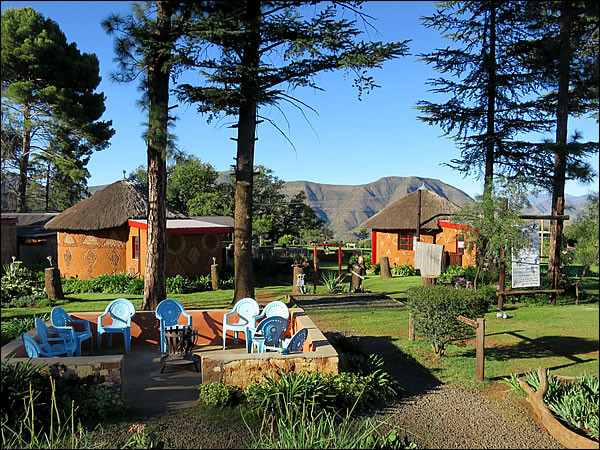

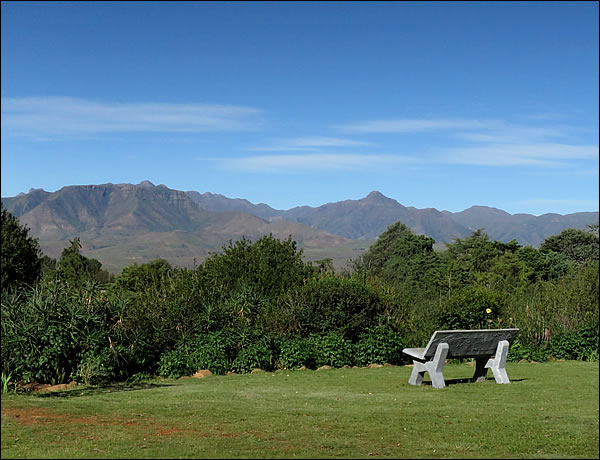
I seriously thought that the first two days in Lesotho could not be surpassed in any way and that from here on I could only expect a slightly less rewarding visit. I could not have been more wrong. On the third day I drove into the center of the country on a nice, paved road that took me up and down the mountains, into valleys, out of valleys, up on high ground, down on not so high ground. There was not a straight stretch of road that lasted longer than a gear change. The serpentine of a road that I followed clung to the mountain side following every topographical feature as tightly as a Cambodian sales tout follows a tourist.
In places I drove on high plateaus where the views became a concern for road safety. In the lower lands there were fields of white and pink flowers that mesmerized any spectator. One could also spot the first signs of approaching autumn in form of yellow leaves on the trees growing along the rivers deep in the valleys. I enjoyed every minute of the days drive and when I came to rest in the town of Thaba-Tseka I was so full of impressions that only a handful of the local brew Maluti could make my brain comprehend.
How could anything top this?
The answer was simple. I just had to get on the bike the next day and take on a dirt road that led to the Katse dam. It was a good dirt road without any difficulties. It did make me drive slower and thereby I was able to appreciate the landscape even more. The water reservoir behind the dam added another color to the green scenery. Environmentalists may claim that dams are intrusions in the landscape but I think that they many times, especially in dry areas, enhance the nature. A featureless, dull world can become interesting and attractive and full of life.
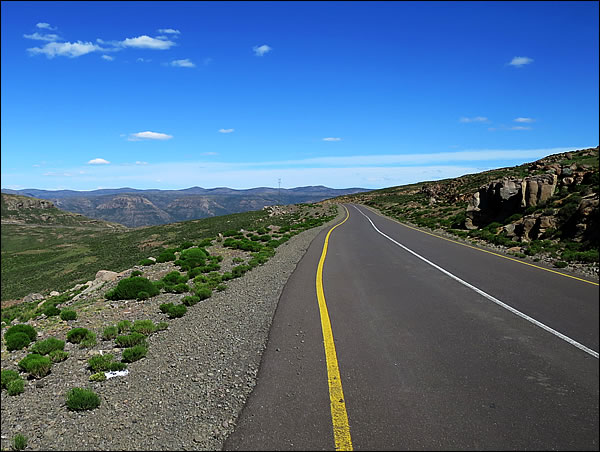
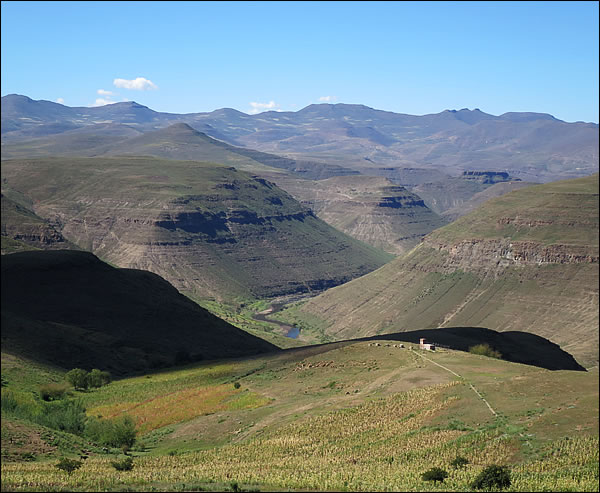
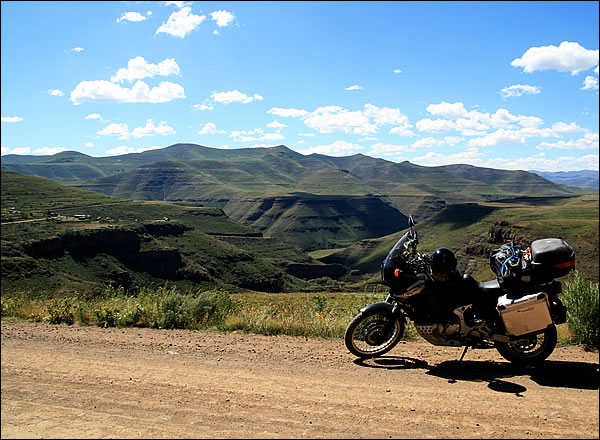
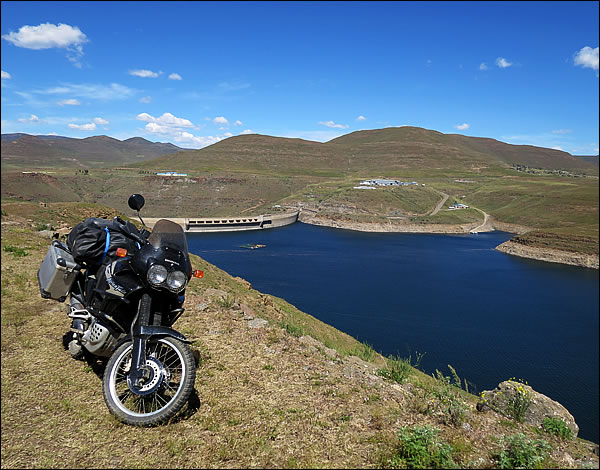
At the dam I was again back on the paved road and one section had smooth curve upon smooth curve upon smooth curve and then ... a bunch of smooth curves. It was also slightly uphill which makes it easy to brake just in case it should get out of hand. It was like a race track but instead of curves designed for highly skilled race drivers, these curves were made for drivers that sit comfortable in the saddle and don’t like to get their knees scratched. I could have sworn that the person that had engineered this road must have been an avid motorcyclist. This was probably his own special playground. I just had to turn around and drive it one more time.
Right after this passage the road went straight up from 2 100 at the reservoir to over 3 000 meters and back into the landscape of immense views, but not for long. As I came over a pass the road just disappeared down the mountain side. Hey, where did you go?
This was a highly dramatic decent where the road engineers had been put to the outmost test to make the road stick to the mountain side, or rather the cliff side.
After an hour or two on the low lands, that is at 1 500 meters, along the north western border it started uphill again and after yet another mountain pass I decided to call it a day. I spent the night in the Oxbow Lodge at 2 500 meters above sea level and it was a bit nippy at night.
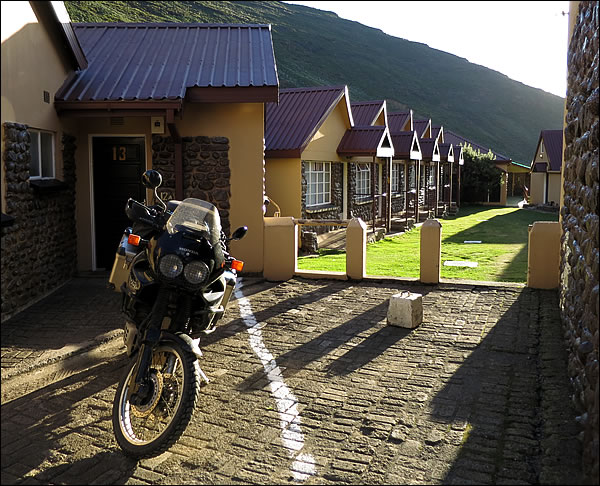
The highest passage followed the next day at the Tlaeen Pass which is at an altitude of 3 275 meters. Up there was a small ski resort that was waiting for the first snow of the year. I also passed a large diamond mine in the middle of nowhere. It was quite cold to drive in the morning hours but as I descended down into yet another valley the sun got its power back and warmed me up again. Up at the higher altitudes in Lesotho where the wind is the master, there are few houses. The only people who defy this harsh and barren landscape are the herdsmen, usually young men or boys clad in blankets and balaclava-type head garments. Sometimes you see only bare legs and bare arms under the blankets.
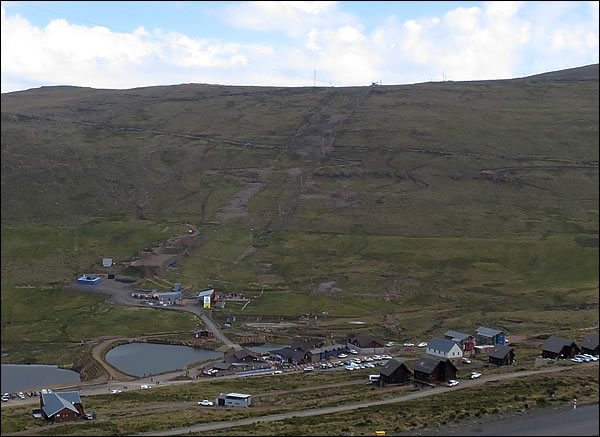
After five days in Lesotho my impression bank was completely full and needed to be processed. I had entered Lesotho in the south west corner at the Tele Bridge and was now going to leave in the east corner. This seemed like a logical route when laid out on a map. Even if I had extended it a bit by delving deeper into the country and thereby bypassing the capital Maseru, it still looked very sensible and aesthetic as I lined it out on the geographical piece of paper.
There was only one little hitch of which magnitude I was not fully aware. Leaving Lesotho in the eastern corner means that you have to go down the famous, or perhaps I should say, the infamous Sani Pass Road. This is a road that drops over the edge of the Drakensberg down a very steep and very narrow gully into a valley below by means of a dozen or so heart raising hairpin curves. And it’s dirt road, rough dirt road.
But that is a story of its own.
/AB
More photos of Lesotho can be found here.
|














